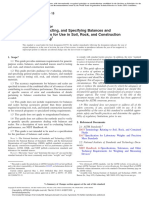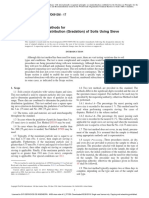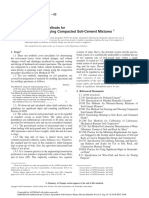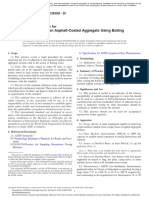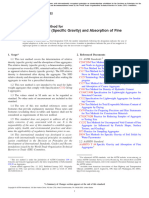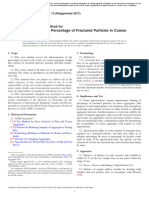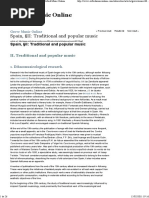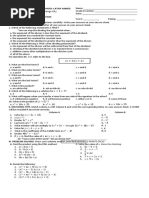Evaluating, Selecting, and Specifying Balances and Standard Masses For Use in Soil, Rock, and Construction Materials Testing
Evaluating, Selecting, and Specifying Balances and Standard Masses For Use in Soil, Rock, and Construction Materials Testing
Uploaded by
AhmedJardakCopyright:
Available Formats
Evaluating, Selecting, and Specifying Balances and Standard Masses For Use in Soil, Rock, and Construction Materials Testing
Evaluating, Selecting, and Specifying Balances and Standard Masses For Use in Soil, Rock, and Construction Materials Testing
Uploaded by
AhmedJardakOriginal Title
Copyright
Available Formats
Share this document
Did you find this document useful?
Is this content inappropriate?
Copyright:
Available Formats
Evaluating, Selecting, and Specifying Balances and Standard Masses For Use in Soil, Rock, and Construction Materials Testing
Evaluating, Selecting, and Specifying Balances and Standard Masses For Use in Soil, Rock, and Construction Materials Testing
Uploaded by
AhmedJardakCopyright:
Available Formats
Designation: D4753 – 07
Standard Guide for
Evaluating, Selecting, and Specifying Balances and
Standard Masses for Use in Soil, Rock, and Construction
Materials Testing1
This standard is issued under the fixed designation D4753; the number immediately following the designation indicates the year of
original adoption or, in the case of revision, the year of last revision. A number in parentheses indicates the year of last reapproval. A
superscript epsilon (´) indicates an editorial change since the last revision or reapproval.
1. Scope* “standard mass(es)” is used instead of standard “standard weight(s)” when
referring to a piece of material of known specified mass used to compare
1.1 This guide provides minimum requirements for general- or measure the mass of other masses.
purpose scales, balances, and standard masses used in testing
soil, rock, and related construction materials. 1.8 This guide offers an organized collection of information
1.2 This guide provides guidance for evaluating, selecting, or a series of options and does not recommend a specific
and specifying general purpose scales, balances, and standard course of action. This document cannot replace education or
masses used in testing soil, rock, and related construction experience and should be used in conjunction with professional
materials. judgement. Not all aspects of this guide may be applicable in
1.3 The accuracy requirements for balances and scales are all circumstances. This ASTM standard is not intended to
specified in terms of the combined effect of all sources of error represent or replace the standard of care by which the
contributing to overall balance performance. The measurement adequacy of a given professional service must be judged nor
of specific sources of error and consideration of details should this document be applied without consideration of a
pertaining to balance construction have been intentionally project’s many unique aspects. The word “Standard” in the
avoided. title of this document means only that the document has been
1.4 This guide does not include requirements for balances approved through the ASTM consensus process.
and scales having accuracies greater than those generally 2. Referenced Documents
required in testing soil, rock, and related construction materials
or for research programs or specialized testing requirements. 2.1 ASTM Standards:2
1.5 This guide does not apply to nongraduated balances. D653 Terminology Relating to Soil, Rock, and Contained
1.6 This guide does not address the methods used to verify Fluids
or quantify specific parameters dealing with balances and E617 Specification for Laboratory Weights and Precision
scales. For a description of tests used in evaluating balance Mass Standards
performance, see NIST Handbook 44. 2.2 National Institute of Standards and Technology Docu-
1.7 This guide is not intended to be used as a specification ments:
for the purchase of balances and scales. NIST Handbook 44 Specifications, Tolerances, and Other
Technical Requirements for Weighing and Measuring
NOTE 1—The National Institute of Standards and Technology (NIST), Devices3
formerly the National Bureau of Standards (NBS), and the International 2.3 International Organization for Legal Metrology
Organization of Legal Metrology (OIML) publish standards or practices
that specify construction requirements as well as performance guides for
(OIML):
balances. ASTM, OIML, and NIST publish construction standards and International Recommendation No. 20 Weights of Accu-
tolerances for standard masses. racy Classes E1, E2, F1, F 2, M1 from 50 kg to 1 mg4
NOTE 2—The terms “mass” and “determine the mass of” are used in
this standard instead of the more commonly used terms “weight” and
“weigh” to comply with standard metric practice. In addition, the term 2
For referenced ASTM standards, visit the ASTM website, www.astm.org, or
contact ASTM Customer Service at service@astm.org. For Annual Book of ASTM
Standards volume information, refer to the standard’s Document Summary page on
1
This guide is under the jurisdiction of ASTM Committee D18 on Soil and Rock the ASTM website.
3
and is the direct responsibility of Subcommittee D18.91 on Standards Development Available from National Institute of Standards and Technology (NIST), 100
and Review. Bureau Dr., Stop 1070, Gaithersburg, MD 20899-1070, http://www.nist.gov.
4
Current edition approved July 15, 2007. Published August 2007. Originally Available from U.S. Government Printing Office Superintendent of Documents,
approved in 1987. Last previous edition approved in 2002 as D4753 – 02. DOI: 732 N. Capitol St., NW, Mail Stop: SDE, Washington, DC 20401, http://
10.1520/D4753-07. www.access.gpo.gov.
*A Summary of Changes section appears at the end of this standard.
Copyright. (C) ASTM International. 100 Barr Harbour Drive, PO box C700 West Conshohocken, PA United States
Copyright by ASTM Int'l (all rights reserved); 1
D4753 – 07
4
International Recommendation No. 3 mass. Thus, obtaining enough values of the true applied mass
versus balance reading to establish a relation between applied
3. Terminology mass and output should give the error that will occur at any
3.1 Definitions: For definitions of terms used in this guide applied mass. Linearity, then, is a statement about the system-
refer to Terminology D653. atic (nonrandom) error of a balance. Superimposed on the
3.2 Definitions of Terms Specific to This Standard: linearity are precision and other effects, such as off-center
3.2.1 accurate—a balance is “accurate” when its perfor- errors, temperature effects, etc. Linearity is a measure of
mance (its indication as determined by tests made with suitable balance performance over its full range, and on most balances
standards) conforms to the standard within the applicable adjustments can be made to alter the useableness of a balance
tolerances and other performance requirements. Balances that with a given linearity for measurements within a particular
fail to conform are “inaccurate.” range of use.
3.2.2 balance—an instrument for determining the mass of 3.2.12 nongraduated balance—balances not fitted with a
an object by the action of gravity on the object. See scale. scale numbered in units of mass.
3.2.2.1 Discussion—In this guide and in common usage, the 3.2.13 off-center error—of a top loading or platform bal-
terms balance and scale are used interchangeably. The term ance, the difference in indicated value when a mass is shifted
balance is more often used in scientific fields of application. to various positions on the loading area (pan or platform);
The term scale usually refers to instruments intended for eccentric load error.
commercial or industrial applications, and when so used, 3.2.13.1 Discussion—The test for off-center error is called
usually implies an instrument of lesser performance than a the shift test, or offcenter-load test. Information about balance
balance. performance under eccentric loadings is not normally found in
3.2.3 basic condition—a condition that must be met before product literature but such information can usually be obtained
a basic measurement for evaluating a balance can be per- by contacting the manufacturer directly.
formed.
3.2.14 precision of a balance—the degree of agreement
3.2.4 basic measurement (of error)—a basic measurement
between the indications of a balance for repeated determina-
for evaluating a balance is performed by (1) determining the
tions of mass of the same mass under essentially the same
change of indication of the balance when a known mass is
conditions. It is usually expressed quantitatively as a standard
added to or subtracted from any mass already on the balance;
deviation of a series of mass determinations, or as a function of
and (2) taking the difference between the change in the
the range of several mass determinations. See repeatability
indication determined and the known value of the mass.
type II, reproducibility.
3.2.5 basic tolerance—tolerances that are established by a
particular code for a particular device under all normal tests, 3.2.15 readability type I—the value of the smallest unit of
whether maintenance or acceptance. Basic tolerances include mass that can be read without estimation over the given range
minimum tolerance values when these are specified. Special of measurement either directly or by use of a vernier or
tolerances, identified as such and pertaining to special tests, are micrometer.
not basic tolerances. 3.2.16 readability type II—the value of the smallest unit of
3.2.6 capacity—of a balance, the maximum mass recom- mass that can be read with estimation over the given range of
mended by the manufacturer, disregarding any additional measurement.
capability supplied by a taring device. 3.2.17 readability type III—the value of the smallest unit of
3.2.7 general-purpose balance—any balance used to make mass that can be read when in-service conditions such as draft,
a general purpose determination of mass. See general-purpose vibration, and other environmental conditions affect the bal-
determination of mass. ance while the balance is in use, but not smaller than
3.2.8 general-purpose determination of mass—a single de- readability Type I.
termination of mass using a balance (not a special purpose 3.2.18 repeatability type I—the degree of agreement be-
determination of mass involving repeat determinations of tween the indications of a balance for repeated determinations
mass, averages, standard deviations, corrections, etc.). of the same mass under essentially the same conditions. The
3.2.9 general-purpose standard mass—a standard mass degree of agreement (qualitatively).
used with a balance to make a general purpose determination of 3.2.19 repeatability type II—see precision of a balance.
mass. See general-purpose determination of mass. 3.2.20 reproducibility—see precision of a balance.
3.2.10 hysteresis—the difference between successive mea- 3.2.21 scale—see balance.
surements of a standard mass when the standard mass is 3.2.22 sensitivity—the ratio of the deflection (DL) of the
measured after a cycle of adding, and then removing (or balance indicator or self-indicating display to the mass (DM)
removing, then adding) mass from the balance. causing the deflection; S = DL/DM at a given mass.
3.2.11 linearity error—plus or minus deviation from the
theoretically straight-lined (linear) course of two interdepen- NOTE 3—Values for sensitivity are sometimes seen expressed in terms
dent values. In balances, this expression is applied to the plus of mass units. When used in this way in reference to a nonself-indicating
balance, sensitivity refers to the reciprocal of sensitivity or the change in
or minus deviation of the indicated measurement value from mass required to change the position of equilibrium (rest point) a specified
the true (actual) value of the mass. amount, usually one division on the balance indicator. When used in
3.2.11.1 Discussion—Linearity implies that the deviation reference to self-indicating balances, it refers to the change in mass
from the true values are a continuous function of the applied required to change the indication by one scale division.
Copyright by ASTM Int'l (all rights reserved); 2
D4753 – 07
3.2.23 standard mass—an object of specified mass and TABLE 2 Maintenance Tolerances for General-Purpose Standard
construction used with balances, and for the verification of Masses
balances and other masses. Denomination Tolerance,A mg
3.2.24 taring range—a range within which it is possible to 20 kg 4000
reset the indicator or display to zero by use of the tare device. 10 kg 2000
5 kg 1000
3.2.25 tolerance—a value fixing the limit of allowable error 3 kg 600
or departure from true performance or value. 2 kg 400
1 kg 200
NOTE 4—For additional terms used in this guide related to balances and 500 g 100
standard masses, see NIST Handbook 44 or OIML IR No. 3. 300 g 60
200 g 40
4. Significance and Use 100 g 20
50 g 14
4.1 This guide provides those using standards related to soil, 30 g 10
rock, and related construction materials, with a means for 20 g 6
10 g 4
selecting the balance required for a particular standard. 5g 4
4.2 This guide provides those writing standards pertaining 3g 4
2g 4
to soil, rock, and related construction materials with a means 1g 4
for specifying the balance capabilities required for a particular 500 mg 2
standard and for describing the balance selected in a uniform 300 mg 2
200 mg 2
fashion. 100 mg 2
4.3 This guide provides agencies conducting soil, rock, and A
Acceptance tolerances on new general-purpose standard masses are one-half
related construction materials, testing with guidance for select- the tolerances shown in this table.
ing and evaluating general purpose balances and standard
masses.
4.4 This guide provides inspection organizations with crite- NOTE 5—Former NIST Class J, M, S, S-1, P, and Q standard masses
ria for evaluating general purpose balances and standard meet this guide, as do OIML Class M1 standard masses (IR No. 20).
masses.
7. Evaluation of General-Purpose Balances
5. Requirements for General-Purpose Balances 7.1 Basic Tolerance—Table 1 shows the basic tolerances for
5.1 General-purpose balances shall be judged accurate for a all classes of general-purpose balances used in soil or rock
given class if their indications meet the basic tolerances shown testing that are covered by this guide. The basic tolerances
in Table 1. shown apply to basic measurements made when evaluating a
balance.
6. Requirements for General-Purpose Masses 7.1.1 A basic measurement for evaluating a balance is
6.1 General-purpose standard masses for use in verification performed by determining the change of indication of the
balances and testing of soil and rock shall conform to the balance when a known mass is added to or subtracted from any
requirements in Specification E617 for Type I or Type II, Grade mass already on the balance, and then taking the difference
S, O, or P standard masses and have tolerance limits equal to between the change in the indication determined and the
or better than those for Class 6 standard masses except that the known value of the mass. To evaluate a balance, the basic
maintenance tolerances given in Specification E617 for Class 6 tolerances shown in Table 1 are applied to the known value of
standard masses are to be considered acceptance tolerances for the mass used in the basic measurement. The result of a basic
purposes of this guide and the maintenance tolerances twice measurement must fall within the error allowed by the basic
those values. The tolerances values given in Table 2 correspond tolerance.
to the minimum acceptable maintenance tolerances under this NOTE 6—For nearly all determinations of mass encountered in soils
guide. testing, the value of interest is the difference between two determinations
of mass. In cases where the difference between the two determinations of
TABLE 1 Requirements for General-Purpose Balances
mass is small, relative to the total masses determined, it is desirable to
specify a tolerance based on the difference between the two determina-
Basic Readability tions of mass to relieve what might otherwise be an excessively stringent
Class Test Mass,A g
Tolerance Type I,B g
tolerance.
GP1 $20 60.1 % 0.01 NOTE 7—A no load condition may be treated as a mass of 0.0 g and may
<20 60.02 g 0.01 be considered a mass on the balance.
GP2 $200 60.1 % 0.1
<200 60.2 g 0.1 7.1.2 The basic tolerance for a balance should apply to all
GP5 $2000 60.1 % 1
<2000 62 g 1
values of loading within the range of the balance without
GP10 $5000 60.1 % 5 regard to whether the balance is properly zeroed or a tare mass
<5000 65 g 5 is being used, and should apply under all usual and customary
GP100 $50 000 60.1 % 50
<50 000 650 g 50
methods of operation. Furthermore, the basic tolerance must be
A
met in the environment in which the balance is to be used.
The known mass which is added to or subtracted from any mass already on
the balance when making a basic measurement (of error). 7.1.3 A balance shall not be considered acceptable if the
B
Not readability Type II. result of basic measurements involving any combination of
Copyright by ASTM Int'l (all rights reserved); 3
D4753 – 07
poise locations, counterpoise masses, pan loading, and scale a balance should be performed as and where the balance is used
positions, or unit masses are not within the basic tolerances to make general purpose determinations of mass. In-use tests
shown in Table 1. are intended to indicate the quality of usual and customary
7.1.4 When evaluating top loading balances, results of basic mass determinations that are made or may be made when using
measurements under off-center loading must also meet basic a general-purpose balance. The basic tolerance should apply to
tolerances. basic measurements for this test.
NOTE 8—The possibility of off-center error and linearity error should 7.5 Rejection—If a balance fails when in-use tests are
be considered when making basic measurements. performed then maintenance tests should be performed. If a
7.1.5 Standard masses meeting or exceeding the require- balance fails both in-use and maintenance tests, it should be
ments given in Specification E617 for weights of Type I or removed from service and repaired or replaced. If a balance
Type II, Grades S or O, and Class 2 are suggested in fails the in-use test but passes the maintenance test, the
Specification E617 for use as working standards for calibration environment in which the balance is located must be improved.
and precision analytical work and are recommended in this
guide for use in evaluating general purpose balances. The use 8. Evaluation of General-Purpose Standard Masses
of standard masses of lesser quality for calibration purposes is 8.1 General-purpose standard masses should be tested on a
discouraged because of the tendency to think of them as precision balance. Standard masses meeting or exceeding the
accurate once they are labeled “standard masses for calibra- requirements given in Specification E617 for standard masses
tion.” of Type I or Type II, Grades S or O, and Class 2 are suggested
7.2 Balance Classification—A balance is classified by ref- in Specification E617 for use as working standards for calibra-
erence to its readability Type I (see Table 1). tion and precision analytical work and are recommended in this
guide for use in evaluating general purpose standard masses.
NOTE 9—Capacity is not to be considered when classifying a balance.
Balance classification in this guide is based on balance performance, not The use of standard masses of lesser quality for calibration
on use requirements. When selecting a balance, the anticipated masses purposes is discouraged because of the tendency to think of
which the balance is expected to measure will dictate the capacity them as accurate once they are labeled “standard masses for
required. calibration.”
7.3 Basic Conditions—A basic condition is a condition 8.2 General-purpose standard masses that fail to meet the
which must be met before a basic measurement for evaluating requirements specified in Section 6 should be removed from
a balance can be performed. In general, basic conditions service and either adjusted to meet acceptance tolerances or
require that a balance give a clear and stable indication under replaced.
any condition of loading including the indication at no load.
Both the useable readability (readability Type III) and the 9. Selecting and Specifying Balances
repeatability Type I must be adequate to perform the basic 9.1 Selecting Balances—The selection of a balance is based
measurements described in 7.1. on the proposed use. A balance must have a capacity sufficient
NOTE 10—For example, when a determination of mass is made with a to accommodate all anticipated test masses, and its perfor-
beam balance, if the smallest poise is moved by an amount equal to the mance must be good enough so as not to be a cause of test
readability Type I, the indicating pointer must move clearly off balance error. The accuracy desired in test results should be used to
(usually at least one division on the pointer scale). This is an indication of establish the allowable balance tolerances.
the adequacy of the sensitivity of a balance.
9.1.1 The precision of a balance (a term frequently found in
7.3.1 Readability Type I (not Type II) establishes the bal- manufacturer’s specifications), expressed as a standard devia-
ance’s class for determining the appropriate basic tolerance. If tion, shall not be greater than twice the readability Type I (not
environmental or other factors cause the usable readability Type II).
(readability Type III) to be poorer than the readability Type I
9.1.2 When listed by the manufacturer, the linearity error of
then the balance cannot meet the basic tolerance for its class.
a balance shall not be greater than twice the readability Type I
7.3.2 The repeatability Type I of the balance being evalu-
(not Type II).
ated must be such that the difference between the highest and
lowest values in a group of several determinations of a mass 9.1.3 If the maximum error of indication contributed by
shall not be greater than twice the balance’s readability Type I. off-center loading can be obtained from the manufacturer, it
7.4 Balance Testing—Two types of testing may be per- should be no greater than twice the readability Type I (not Type
formed when evaluating the performance of a balance. II).
7.4.1 Maintenance Testing—Maintenance testing should be 9.1.4 In cases where a test requires that more than one test
performed on balances in service. The basic measurement for result be determined, several balances having different capa-
evaluating a balance is performed in an environment that meets bilities may be required.
the manufacturer’s recommendations. Maintenance testing is 9.2 Specifying Balances—An example of the wording that
performed to determine whether a balance should be repaired. may be used to specify balances in ASTM standards is as
A tolerance equal to or better than the basic tolerance should follows:
apply to all basic measurements for this test. 9.2.1 Balance—A balance having a minimum capacity of
7.4.2 In-Use Testing—In-use testing should be performed ___ g or kg and meeting the requirements of Guide D4753 for
on balances in service. The basic measurement for evaluating a balance of ___ g readability.
Copyright by ASTM Int'l (all rights reserved); 4
D4753 – 07
9.2.2 Balance—A balance or scale conforming to the re- readability of balances used to determine masses of less than 20 g.
quirements of Guide D4753 readable (with no estimation) to
0.1 % of the test mass, or better. 10. Keywords
NOTE 11—Special consideration may be required when specifying the 10.1 balance; scale; standard masses
ANNEXES
(Mandatory Information)
A1. Annex Examples of Selecting a Specified Balance
A1.1 Assume that a test method requires that the particle A1.2 Assume that a test method requires that the dry unit
sizes of a specimen be determined and that the size fraction be weight of a specimen be determined to four significant digits.
reported to the nearest 0.1%. If the specimen mass is 1000 g, The test method states that the balance be readable with no
then a balance having a minimum readability of determining estimation to 0.1 of the test mass. If the mass of the specimen
the mass of each fraction to the nearest gram (0.1 % of the total is 100 g, the balance must be readable to 0.1 g. If the mass of
mass) will be required. If the specimen mass is 5000 g, then a the specimen is 500 g, the balance must be readable to 0.1 g.
balance having a minimum readability of determining the mass The mass of the specimen would have to be 1000 g before the
of each fraction to the nearest 5 grams (0.1 % of the total mass) readability of the balance would be 1 g.
will be required.
A2. Annex Examples of Specifying a Balance When Writing Standards
A2.1 Assume that a test method requires that a specimen of weight of a specimen be determined to four significant digits,
soil be graded and that the fractions be reported to the nearest therefore, the test method will require that the balance be
0.1 %. If the specimen mass is 1000 g, then a balance having readable with no estimation to 0.1 % of the test mass (i.e., 1
a minimum readability of determining the mass of each part in 1000). If the mass of the specimen is 100 g, the balance
fraction to the nearest gram (0.1 % of the total mass) will be must be readable to 0.1 g. If the mass of the specimen is 500
required. If the specimen mass is 5000 g, then a balance having g, the balance must be readable to 0.1 g. The mass of the
a minimum readability of determining the mass of each specimen would have to be 1000 g before the readability of the
fraction to the nearest 5 grams (0.1 % of the total mass) will be balance would be 1 g. The balance statement would read “A
required. Depending on the specimen size, either a GP5 or a balance having a minimum capacity of 500 g and meeting the
GP10 would be required. The balance statement would be as
requirements of Guide D4753 readable (with no estimation) to
specified in 9.2.2.
0.1 % of the test mass, or better.” This is in accordance with the
A2.2 Assume that a test method requires that the dry unit balance statement specified in 9.2.1
SUMMARY OF CHANGES
Committee D18 has identified the location of selected changes to this standard since the last issue
(D4753 – 02) that may impact the use of this standard. (Approved July 15, 2007.)
(1) Updated the definition of hysteresis.
Copyright by ASTM Int'l (all rights reserved); 5
D4753 – 07
ASTM International takes no position respecting the validity of any patent rights asserted in connection with any item mentioned
in this standard. Users of this standard are expressly advised that determination of the validity of any such patent rights, and the risk
of infringement of such rights, are entirely their own responsibility.
This standard is subject to revision at any time by the responsible technical committee and must be reviewed every five years and
if not revised, either reapproved or withdrawn. Your comments are invited either for revision of this standard or for additional standards
and should be addressed to ASTM International Headquarters. Your comments will receive careful consideration at a meeting of the
responsible technical committee, which you may attend. If you feel that your comments have not received a fair hearing you should
make your views known to the ASTM Committee on Standards, at the address shown below.
This standard is copyrighted by ASTM International, 100 Barr Harbor Drive, PO Box C700, West Conshohocken, PA 19428-2959,
United States. Individual reprints (single or multiple copies) of this standard may be obtained by contacting ASTM at the above
address or at 610-832-9585 (phone), 610-832-9555 (fax), or service@astm.org (e-mail); or through the ASTM website
(www.astm.org).
Copyright by ASTM Int'l (all rights reserved); 6
You might also like
- Saa6d170e-3 Engine PDFDocument90 pagesSaa6d170e-3 Engine PDFamin100% (4)
- Total Evaporable Moisture Content of Aggregate by Drying: Standard Test Method ForDocument3 pagesTotal Evaporable Moisture Content of Aggregate by Drying: Standard Test Method ForYarisel Shosha MuñozNo ratings yet
- Astm D7175Document16 pagesAstm D7175jegancivil100% (1)
- Measurement of Hydraulic Conductivity of Porous Material Using A Rigid-Wall, Compaction-Mold PermeameterDocument8 pagesMeasurement of Hydraulic Conductivity of Porous Material Using A Rigid-Wall, Compaction-Mold PermeameterOpu Debnath100% (1)
- RBEC PELC Science and HealthDocument51 pagesRBEC PELC Science and Healthglenn0104No ratings yet
- D4753 19711 PDFDocument6 pagesD4753 19711 PDFeduardo bonillaNo ratings yet
- Astm C128 22Document4 pagesAstm C128 22Leon ZidaneNo ratings yet
- Aashto T217-14 (2022)Document7 pagesAashto T217-14 (2022)jaheshfarhadNo ratings yet
- D 2434-19-PermeabilidadDocument6 pagesD 2434-19-PermeabilidadJose Luis Talaverano NajarroNo ratings yet
- Penetration of Bituminous Materials: Standard Test Method ForDocument4 pagesPenetration of Bituminous Materials: Standard Test Method ForJanardhana ReddiNo ratings yet
- Astm C1252-23Document6 pagesAstm C1252-23Hani YilmazNo ratings yet
- Astm D4718D4718M-15Document3 pagesAstm D4718D4718M-15Jha AcostaNo ratings yet
- Laboratory Determination of Water (Moisture) Content of Soil and Rock by MassDocument7 pagesLaboratory Determination of Water (Moisture) Content of Soil and Rock by MassDiego PullesNo ratings yet
- Preparation of Test Specimens of Asphalt-Stabilized Soils: Standard Practice ForDocument5 pagesPreparation of Test Specimens of Asphalt-Stabilized Soils: Standard Practice Forโก อู๋No ratings yet
- Splitting Tensile Strength of Intact Rock Core Specimens With Flat Loading PlatensDocument6 pagesSplitting Tensile Strength of Intact Rock Core Specimens With Flat Loading PlatensAndreyriv DiazNo ratings yet
- D2167 PDFDocument6 pagesD2167 PDFMohd SulaimanNo ratings yet
- ASTM C1609 - C1609M - 19a Standard Test Method For Flexural Performance of Fiber-Reinforced Concrete (Using Beam With Third-Point Loading)Document5 pagesASTM C1609 - C1609M - 19a Standard Test Method For Flexural Performance of Fiber-Reinforced Concrete (Using Beam With Third-Point Loading)ming_zhu10No ratings yet
- Particle-Size Distribution (Gradation) of Soils Using Sieve AnalysisDocument34 pagesParticle-Size Distribution (Gradation) of Soils Using Sieve AnalysisJP SALDAÑANo ratings yet
- Minimum Requirements For Agencies Testing and Inspecting Road and Paving MaterialsDocument7 pagesMinimum Requirements For Agencies Testing and Inspecting Road and Paving Materialsاحمد علي احمدNo ratings yet
- C1603.29733 - Solidos AguaDocument4 pagesC1603.29733 - Solidos AguaEliasTalaAllcaNo ratings yet
- ASTM D 546 Sieve Analysis of Mineral Filler For Bituminous Paving MixturesDocument2 pagesASTM D 546 Sieve Analysis of Mineral Filler For Bituminous Paving MixturesYasir DharejoNo ratings yet
- Astm C 936Document3 pagesAstm C 936vidhisukhadiya100% (1)
- Astm D1883-16Document14 pagesAstm D1883-16Andrés Grefa JaraNo ratings yet
- Wetting and Drying Compacted Soil-Cement Mixtures: Standard Test Methods ForDocument7 pagesWetting and Drying Compacted Soil-Cement Mixtures: Standard Test Methods Forjimmy AndresNo ratings yet
- D560D560M 15.PDF (EngPedia - Ir)Document6 pagesD560D560M 15.PDF (EngPedia - Ir)Dastaggir KarimiNo ratings yet
- Calibration of Laboratory Mechanical-Rammer Soil Compactors: Standard Practices ForDocument6 pagesCalibration of Laboratory Mechanical-Rammer Soil Compactors: Standard Practices ForAbid HussainNo ratings yet
- Aashto t27Document4 pagesAashto t27binoNo ratings yet
- Astm C143 C143M 20Document3 pagesAstm C143 C143M 20Mohaa rabiaNo ratings yet
- Consolidated Drained Triaxial Compression Test For SoilsDocument11 pagesConsolidated Drained Triaxial Compression Test For SoilsmickyfelixNo ratings yet
- D2216 2236Document7 pagesD2216 2236Mohan GowdaNo ratings yet
- Density of Soil and Rock In-Place at Depths Below Surface by Nuclear MethodsDocument7 pagesDensity of Soil and Rock In-Place at Depths Below Surface by Nuclear MethodsIonut VasilescuNo ratings yet
- Moisture-Density (Unit Weight) Relations of Soil-Cement MixturesDocument7 pagesMoisture-Density (Unit Weight) Relations of Soil-Cement MixturesHandy100% (1)
- Standard Practice For Reducing Samples of Aggregate To Testing SizeDocument7 pagesStandard Practice For Reducing Samples of Aggregate To Testing Sizejun flores100% (1)
- ASTM-D4254-16 WordDocument12 pagesASTM-D4254-16 WordKaan TekinturhanNo ratings yet
- Organic Impurities in Fine Aggregates For Concrete: Standard Test Method ForDocument2 pagesOrganic Impurities in Fine Aggregates For Concrete: Standard Test Method ForMohamed KhalilNo ratings yet
- AASHTO T 309M-T 309-05 ASTM C 1064-C 1064M-04 Temperature of Freshly Mixed Hydraulic-Cement Concrete-FinalDocument2 pagesAASHTO T 309M-T 309-05 ASTM C 1064-C 1064M-04 Temperature of Freshly Mixed Hydraulic-Cement Concrete-Finalclint silNo ratings yet
- ASTM D3625 Effects of Water On Asphalt Coated Aggregate Using Boiling MethodDocument2 pagesASTM D3625 Effects of Water On Asphalt Coated Aggregate Using Boiling MethodRamy HusseinNo ratings yet
- D2172D2172M 17Document10 pagesD2172D2172M 17mehdiNo ratings yet
- Compressive Strength of Bituminous Mixtures: Standard Test Method ForDocument5 pagesCompressive Strength of Bituminous Mixtures: Standard Test Method Foraastha mehtaNo ratings yet
- Astm C128-22Document6 pagesAstm C128-22Jimmy Johan Tapia VásquezNo ratings yet
- C490 Practice For Use of Apparatus For The Determination ofDocument5 pagesC490 Practice For Use of Apparatus For The Determination ofCarineMolzNo ratings yet
- Determining The Amount of Material Finer Than 75 - M (No. 200) Sieve in Soils by WashingDocument6 pagesDetermining The Amount of Material Finer Than 75 - M (No. 200) Sieve in Soils by WashingIecsa IngenieriaNo ratings yet
- ASTM C 563 - 03 Standard Test Method For Optimum SO3 in Hydraulic Cement Using 24-h Compressive StrengthDocument3 pagesASTM C 563 - 03 Standard Test Method For Optimum SO3 in Hydraulic Cement Using 24-h Compressive Strengthfilipe100% (1)
- Astm D698 12 2021Document7 pagesAstm D698 12 2021someoneNo ratings yet
- AASHTO t255Document6 pagesAASHTO t255Sabila IhsaniNo ratings yet
- Consolidación Con Deformación Controlada (D4186-D4186M-12)Document18 pagesConsolidación Con Deformación Controlada (D4186-D4186M-12)joake spasNo ratings yet
- ASTM D-4753-9502-AmtysywDocument7 pagesASTM D-4753-9502-AmtysywAndres David HerradaNo ratings yet
- Astm D1140Document4 pagesAstm D1140Jony Gutiérrez AbantoNo ratings yet
- Determination of Pore Volume and Pore Volume Distribution of Soil and Rock by Mercury Intrusion PorosimetryDocument8 pagesDetermination of Pore Volume and Pore Volume Distribution of Soil and Rock by Mercury Intrusion PorosimetryWanucy Barroso RodriguesNo ratings yet
- R76Document8 pagesR76Cams SenoNo ratings yet
- Bulk Specific Gravity and Density of Non-Absorptive Compacted Asphalt MixturesDocument4 pagesBulk Specific Gravity and Density of Non-Absorptive Compacted Asphalt MixturesKev SantiagoNo ratings yet
- ASTM D2974-20e1Document6 pagesASTM D2974-20e1Joviann Esquivel100% (1)
- Aashto T 267-86 (2018)Document4 pagesAashto T 267-86 (2018)Maricel NgaganNo ratings yet
- Air Content of Freshly Mixed Concrete by The Pressure MethodDocument7 pagesAir Content of Freshly Mixed Concrete by The Pressure MethodEvert RiveraNo ratings yet
- Astm D5444Document3 pagesAstm D5444karenmerino94100% (1)
- Determining The Percentage of Fractured Particles in Coarse AggregateDocument6 pagesDetermining The Percentage of Fractured Particles in Coarse AggregateJimmy Johan Tapia VásquezNo ratings yet
- Torsional Ring Shear Test To Determine Drained Residual Shear Strength of Cohesive SoilsDocument7 pagesTorsional Ring Shear Test To Determine Drained Residual Shear Strength of Cohesive SoilsPrakash100% (1)
- ASTM-C-289-Potential Alcali-Silice Reactivity of Aggregates PDFDocument8 pagesASTM-C-289-Potential Alcali-Silice Reactivity of Aggregates PDFculicha23No ratings yet
- Astm D4753 15Document3 pagesAstm D4753 15JennifferNo ratings yet
- d4753 15 Standard Guide For Evaluating Selecting and Specifying Balances and Standard Masses For Use in Soil Rock and Construction Materials TestingDocument6 pagesd4753 15 Standard Guide For Evaluating Selecting and Specifying Balances and Standard Masses For Use in Soil Rock and Construction Materials TestingAfra AliNo ratings yet
- Selection of Drilling Methods For Environmental Site CharacterizationDocument17 pagesSelection of Drilling Methods For Environmental Site CharacterizationmickyfelixNo ratings yet
- Using Rock-Mass Classification Systems For Engineering PurposesDocument30 pagesUsing Rock-Mass Classification Systems For Engineering PurposesSFC ABHA 1100% (1)
- Penetration of Bituminous Materials: Standard Test Method ForDocument4 pagesPenetration of Bituminous Materials: Standard Test Method ForAhmedJardakNo ratings yet
- Minimum Index Density and Unit Weight of Soils and Calculation of Relative DensityDocument9 pagesMinimum Index Density and Unit Weight of Soils and Calculation of Relative DensityAhmedJardakNo ratings yet
- One-Dimensional Swell or Collapse of Cohesive Soils: Standard Test Methods ForDocument9 pagesOne-Dimensional Swell or Collapse of Cohesive Soils: Standard Test Methods ForAhmedJardakNo ratings yet
- Determination of The Point Load Strength Index of Rock and Application To Rock Strength ClassificationsDocument11 pagesDetermination of The Point Load Strength Index of Rock and Application To Rock Strength ClassificationsAhmedJardakNo ratings yet
- D6938 - 10 Densité en Place Et Teneur en EauDocument10 pagesD6938 - 10 Densité en Place Et Teneur en EauAhmedJardakNo ratings yet
- Sand Equivalent Value of Soils and Fine Aggregate: Standard Test Method ForDocument9 pagesSand Equivalent Value of Soils and Fine Aggregate: Standard Test Method ForAhmedJardakNo ratings yet
- Japanese Architecture After World War IIDocument12 pagesJapanese Architecture After World War IIKyle EbarneNo ratings yet
- Micropara Prelim CompilationDocument13 pagesMicropara Prelim CompilationNathaniel BudayNo ratings yet
- Bottle Blowing & FillingDocument14 pagesBottle Blowing & Fillingmichael odiemboNo ratings yet
- Inflation & UnemploymentDocument13 pagesInflation & UnemploymentNathaniel MadugaNo ratings yet
- sdfsdfweDocument2 pagessdfsdfweAcadGucciManeNo ratings yet
- Animal Science Cheat Sheet: by ViaDocument3 pagesAnimal Science Cheat Sheet: by ViaGlaiza Abad FernandezNo ratings yet
- Lab 6 OMT-FSM IntegrationDocument28 pagesLab 6 OMT-FSM IntegrationJosh CnNo ratings yet
- Música Popular Española (Oxford Music)Document26 pagesMúsica Popular Española (Oxford Music)BonitaNo ratings yet
- Eao MCDocument100 pagesEao MCdinesh005No ratings yet
- Anthropology and The Study of Gender - Judith ShapiroDocument21 pagesAnthropology and The Study of Gender - Judith ShapiroPaulina RosalesNo ratings yet
- Quiz 1Document2 pagesQuiz 1Raphonzel AlvaradoNo ratings yet
- Chivalry of A Failed Knight Vol. 8Document318 pagesChivalry of A Failed Knight Vol. 8SETi2003No ratings yet
- Upper Latap, Limpapa, Zamboanga CityDocument1 pageUpper Latap, Limpapa, Zamboanga CityJoshua BellotindosNo ratings yet
- Systems Analysis and Design: Analyzing The Business CaseDocument40 pagesSystems Analysis and Design: Analyzing The Business CaseMaxbuub AxmedNo ratings yet
- 6367A ENU CompanionDocument173 pages6367A ENU CompanionSteve HansenNo ratings yet
- Design Byelaws FinalDocument8 pagesDesign Byelaws FinalWahab HussainNo ratings yet
- Academic Calendar For Autumn Semester 2019-20 Indian Institute of Technology RoorkeeDocument2 pagesAcademic Calendar For Autumn Semester 2019-20 Indian Institute of Technology RoorkeeShreyansh JainNo ratings yet
- Input Output Devices AssignmentDocument6 pagesInput Output Devices Assignmentpubg broNo ratings yet
- D T Assignment 2Document12 pagesD T Assignment 2api-333375058No ratings yet
- Crochet World Handmade Crochet Holidays Autumn 2017Document116 pagesCrochet World Handmade Crochet Holidays Autumn 2017Lavana Faye100% (18)
- Martial Peak - Chapter 3 - 147 LossesDocument6 pagesMartial Peak - Chapter 3 - 147 LossesFilipe Martire de MirandaNo ratings yet
- Optical LAN Operations Provisioning & MaintenanceDocument2 pagesOptical LAN Operations Provisioning & MaintenanceFilipi TariganNo ratings yet
- Grade 9 Economics Project PDFDocument3 pagesGrade 9 Economics Project PDFVanita Sharma50% (2)
- Transformer Losses-Regulation-Efficiency Calcualation::Three Phase Transformer DetailDocument4 pagesTransformer Losses-Regulation-Efficiency Calcualation::Three Phase Transformer DetailTHILAKKUMARNo ratings yet
- Computer ArchitecturDocument6 pagesComputer ArchitecturechandanaNo ratings yet
- Dll-Week 2Document3 pagesDll-Week 2LV BENDANA100% (1)
- JO 20221116 MadridDocument65 pagesJO 20221116 MadridMark Leo BejeminoNo ratings yet
- Toilet and Bath Accessories - MSTDocument7 pagesToilet and Bath Accessories - MSTwafikmh4No ratings yet





